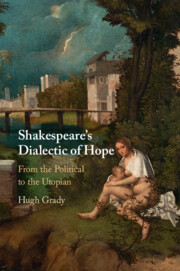Book contents
- Shakespeare’s Dialectic of Hope
- Shakespeare’s Dialectic of Hope
- Copyright page
- Dedication
- Contents
- Acknowledgments
- Part I
- Part II
- Introduction to Part II Shakespeare and the Aesthetic-Utopian
- Chapter 4 From the Political to the Aesthetic-Utopian in Antony and Cleopatra
- Chapter 5 Tyranny, Imagination, and the Aesthetic-Utopian in The Winter’s Tale
- Chapter 6 The Political, the Aesthetic, and the Utopian in The Tempest
- Bibliography
- Index
Chapter 5 - Tyranny, Imagination, and the Aesthetic-Utopian in The Winter’s Tale
from Part II
Published online by Cambridge University Press: 02 June 2022
- Shakespeare’s Dialectic of Hope
- Shakespeare’s Dialectic of Hope
- Copyright page
- Dedication
- Contents
- Acknowledgments
- Part I
- Part II
- Introduction to Part II Shakespeare and the Aesthetic-Utopian
- Chapter 4 From the Political to the Aesthetic-Utopian in Antony and Cleopatra
- Chapter 5 Tyranny, Imagination, and the Aesthetic-Utopian in The Winter’s Tale
- Chapter 6 The Political, the Aesthetic, and the Utopian in The Tempest
- Bibliography
- Index
Summary
In The Winter’s Tale, power, eros, death, the utopian, and the aesthetic are the main themes in play. It begins in a world of amoral and dehumanizing power politics and ends in affirmations of the utopian spirit – while acknowledging the realities of death and suffering. It draws on festival traditions, fairy tales, and ancient issues of resurrection and rebirth in its end and political and psychological issues, as King Leontes becomes a mad tyrant. His madness paradoxically takes an aesthetic form in its (perverse) creativity and reliance on intuitive mental decisions as defined by Kant – thus relating to the aesthetic issues later in the play. The play’s utopian space is a mixed, complicated locus that includes both the utopian and the nonutopian. What makes it a consummate example of Shakespearean metatheater is its investigation of the relations of two concepts of ancient provenance, “art” and “nature,” introduced off-handedly, played with extensively in the second half of the play, and climaxed and thematically resolved in the complex, dissonant unity of the two terms figured when an apparent stone statue of the supposedly dead Queen Hermione is revealed as living flesh.
- Type
- Chapter
- Information
- Shakespeare's Dialectic of HopeFrom the Political to the Utopian, pp. 151 - 192Publisher: Cambridge University PressPrint publication year: 2022

